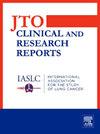Lobectomy Induces Exercise-Induced Pulmonary Hypertension and Effort Intolerance Compared With Sublobar Resection
IF 3.5
Q2 ONCOLOGY
引用次数: 0
Abstract
Introduction
The rationale underlying the benefits of the parenchyma-preserving nature of sublobar resection (SR) compared with lobectomy remains unclear. This study aimed to assess postoperative changes in cardiopulmonary function after lobectomy and SR using exercise stress testing.
Methods
This prospective, observational study enrolled patients scheduled for lobectomy or SR. Changes in cardiopulmonary function at 6 months postoperatively were evaluated using exercise stress echocardiography and cardiopulmonary exercise tests.
Results
Initially, 41 patients were enrolled, with 20 patients in the lobectomy group and 18 patients in the SR group (16 segmentectomies, two wedge resections) after excluding three ineligible patients. Preoperatively, all patients demonstrated well-preserved cardiopulmonary function. The systolic pulmonary artery pressure (SPAP) change at peak exercise was significantly higher for lobectomy (median 26.5%; interquartile range [IQR] 0.6–60.1) than for SR (median −8.2%; IQR −38.7–11.7; p = 0.001), despite nonsignificant differences at rest (p = 0.599). Postoperative exercise-induced pulmonary hypertension (exPH) occurred in nine patients (45%) in the lobectomy group but none in the SR group (0%, p = 0.010). Postoperative peak oxygen consumption during exercise decreased significantly in the lobectomy group (median −14.3%; IQR −24.0 to −4.2) compared with that in the SR group (median −7.8%; IQR −13.5–8.7; p = 0.024). The postoperative increase in SPAP at peak exercise (r = 0.402, p = 0.012), prevalence of postoperative exPH (r = 0.978, p = 0.004), and postoperative decrease in peak oxygen consumption (r = −0.330; p = 0.041) were correlated with the number of resected segments.
Conclusions
Lobectomy induces increased SPAP during exercise, exPH, and effort intolerance, compared with SR. This highlights the importance of preserving lung parenchyma in lung surgery.
Clinical Trial Registration
This trial is registered in the UMIN Clinical Trials Registry under the code UMIN000053694.
与叶下切除术相比,肺叶切除术可诱导运动性肺动脉高压和努力耐受
与肺叶切除术相比,叶下切除术(SR)保留实质的好处的基本原理尚不清楚。本研究旨在通过运动应激试验评估肺叶切除术和SR术后心肺功能的变化。方法:本前瞻性观察性研究纳入了计划行肺叶切除术或手术后6个月心肺功能变化的患者,采用运动应激超声心动图和心肺运动试验进行评估。结果最初纳入41例患者,其中肺叶切除术组20例,SR组18例(16节段切除术,2例楔形切除术),排除了3例不符合条件的患者。术前,所有患者均表现出良好的心肺功能。肺叶切除术患者在运动高峰时的肺动脉收缩压(SPAP)变化(中位数26.5%;四分位间距[IQR] 0.6-60.1)显著高于SR组(中位数- 8.2%;IQR - 38.7-11.7; p = 0.001),尽管静止时差异不显著(p = 0.599)。肺叶切除术组有9例(45%)患者出现术后运动性肺动脉高压(exPH), SR组无一例(0%,p = 0.010)。肺叶切除术组术后运动时峰值耗氧量明显低于SR组(中位数为- 7.8%,IQR为- 13.5-8.7,p = 0.024)(中位数为- 14.3%,IQR为- 24.0 - - 4.2)。术后运动峰值SPAP升高(r = 0.402, p = 0.012)、术后exPH发生率(r = 0.978, p = 0.004)、术后峰值耗氧量下降(r = - 0.330, p = 0.041)与切除节段数相关。结论与手术相比,手术切除可导致运动时SPAP、exPH和力耐受增加,这突出了在肺手术中保留肺实质的重要性。临床试验注册本试验在UMIN临床试验注册中心注册,代码为UMIN000053694。
本文章由计算机程序翻译,如有差异,请以英文原文为准。
求助全文
约1分钟内获得全文
求助全文
来源期刊

JTO Clinical and Research Reports
Medicine-Oncology
CiteScore
4.20
自引率
0.00%
发文量
145
审稿时长
19 weeks
 求助内容:
求助内容: 应助结果提醒方式:
应助结果提醒方式:


